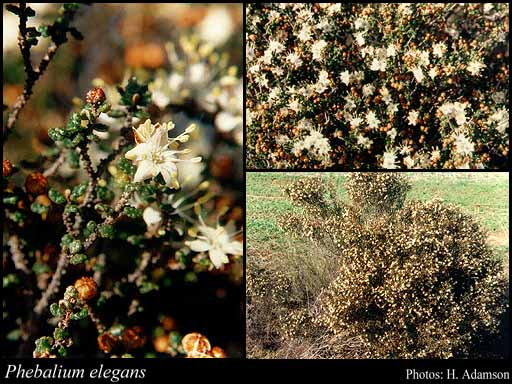- Reference
- Nuytsia 12(2):282 (1998)
- Conservation Code
- Not threatened
- Naturalised Status
- Native to Western Australia
- Name Status
- Current
Spreading shrub, 0.3-1.5 m high, leaves cuneate, ca 5 mm long; umbels terminal, 2-5-flowered; pedicels slender, 5-10 mm long. Fl. white, Jul to Sep. Sandy or granitic loam. Granite outcrops, rocky slopes.

Scientific Description
Shrub, spines absent; branchlets verrucose (warty), +/- cylindrical in cross-section, covered in hairs or scales, the hairs stellate (star-shaped) or peltate (umbrella-like) scales. Leaves opposite, simple, 5-7 mm long, 2-2.7 mm wide, flat, the margins recurved or revolute, verrucose (warty), glabrous; stipular excrescences absent. Flowers in terminal umbels; pedicels 4-7 mm long; calyx present, 1-2 mm long, smooth, without distinct raised glands, covered in hairs or scales; corolla white or cream, petals five, 3-6 mm long, imbricate (overlapping), free, lepidote (with scales); stamens twice as many as petals, 2-6 mm long, smooth, glabrous, without an appendage; style 3.5-4 mm long, glabrous. Flowers in July, August and September. Occurs in the Eremaean and South-West Botanical Province, in the Coolgardie and Esperance IBRA region(s).
Distribution
- IBRA Regions
- Coolgardie, Esperance Plains.
- IBRA Subregions
- Eastern Goldfield, Fitzgerald, Mardabilla, Southern Cross.
- Local Government Areas (LGAs)
- Dundas, Ravensthorpe.